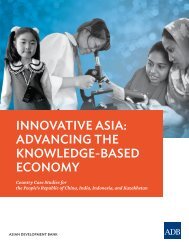ETEE7
ETEE7
ETEE7
Create successful ePaper yourself
Turn your PDF publications into a flip-book with our unique Google optimized e-Paper software.
Highlights Day 1: 10 March 2013 33<br />
and a standardized database of jurisprudence in the region to better understand environmental issues<br />
and develop a judicial strategy to address these issues. Ultimately, there should be a connection between<br />
environmental judges and what is really happening at the district level.<br />
Justice Yang Arif Tan Sri Abdull Hamid bin Embong, justice of the Federal Court of Malaysia, first<br />
thanked ADB for having invited him to speak at this symposium and expressed his newfound awareness<br />
of wildlife issues, including the number of enforcement officers killed while trying to stop the illegal wildlife<br />
trade. Before the symposium, he would only tell the prosecutor to prove his case, while sticking to the<br />
cold facts. He did not care how difficult it was to investigate a case or to enforce the law; and for him, this<br />
should not be the case. He agreed with Justice Shah that frontline green court judges should get involved<br />
in wildlife conferences.<br />
Justice Embong then discussed how Malaysian green court judges first became aware of<br />
environmental issues—starting with the first Asian Judges Symposium in Manila on 28–29 July 2010,<br />
followed by the inaugural ASEAN Chief Justices’ Roundtable on Environment in Jakarta on 5–7 December<br />
2011, the first forum at which ASEAN chief justices sat together and discussed common environmental<br />
challenges. He also recalled that both Chief Justice Zakaria and he were first exposed to environmental<br />
matters during the Asian Judges Symposium. Malaysian judges at the time were completely unaware<br />
of environmental matters. Thus, barely 2 months after the first ASEAN Chief Justices’ Roundtable on<br />
Environment (at the start of the Malaysian legal year in January 2012), Chief Justice Zakaria announced<br />
that Malaysia would establish its own environmental courts and that finally took place 9 months later.<br />
Malaysia now has 50 dedicated green court judges and magistrates. In December 2012, the Federal Court<br />
of Malaysia hosted the Second ASEAN Chief Justices’ Roundtable on Environment in Melaka, Malaysia.<br />
Justice Embong ended his presentation on a positive note. He confidently spoke of more meetings<br />
and discussions at the ASEAN level with the succeeding ASEAN Chief Justices’ Roundtables to be<br />
held in Thailand in 2013 and in Viet Nam in 2014. Again, he thanked ADB for the invitation to attend<br />
this symposium.<br />
Dr. Wanhua Yang, legal officer of the Division of Environmental Law and Conventions of the United<br />
Nations Environment Programme’s (UNEP) Regional Office for Asia and the Pacific, first thanked the<br />
session chairperson, ADB, CITES, and ICCWC for organizing this symposium and for the honor of<br />
speaking on UNEP’s behalf.<br />
Dr. Yang then spoke of UNEP’s role within the United Nations (UN) system as the designated<br />
authority on environmental matters and its role in the development and implementation of international<br />
and national environmental laws and in capacity building on compliance and enforcement. To promote<br />
the judiciary’s vital role in safeguarding environmental justice, UNEP convened the 2002 Global Judges<br />
Symposium in Johannesburg, South Africa, with more than 120 judges from around the world.In 2012,<br />
UNEP partnered with a range of regional and global organizations, including the World Bank, ADB,<br />
INTERPOL, and the CITES Secretariat to convene the World Congress on Justice, Governance and Law<br />
for Environmental Sustainability in Rio de Janeiro, Brazil. This time, UNEP gathered together more than<br />
250 of the world’s most important stakeholder groups in the legal and enforcement communities—chief<br />
justices, senior judges, chief prosecutors, attorneys general, auditors general, and other senior enforcement<br />
officials—to deliberate on the means of improving environmental compliance. The World Congress





